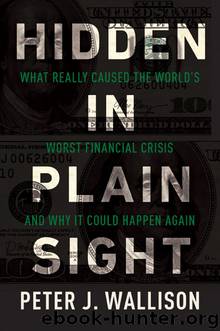Hidden in Plain Sight by Peter J. Wallison

Author:Peter J. Wallison [Wallison, Peter J.]
Language: eng
Format: epub
ISBN: 9781594037719
Publisher: Encounter Books
Adapted from: Fannie Mae, “2007 Housing Goal Plan,” provided to FCIC and numbered FM-FCIC_0172982, p. 8.
aCost analysis for “base” My Community Mortgage enhancement—not layered.
From this report, it is clear that in order to meet the affordable-housing goals, Fannie had to pay up for goals-rich mortgages, taking a huge credit risk along the way. In no sense were these loans profitable; they were more like deferred losses, and when the losses came, both GSEs became insolvent. “Everybody understood that we were now buying loans that we would have previously rejected,” said a former Fannie executive, “but our mandate was to stay relevant and to serve low-income borrowers. So that’s what we did.”46
In a 2005 presentation for HUD, when the housing market was still booming, Fannie reported a litany of complaints associated with meeting the goals:
Having to compromise credit standards and reduce or waive credit enhancement requirements;
Credit enhancement costs at desired levels are too high to win deals;
Deal economics are well below target returns;
Some deals are producing negative cash flows;
Competition driving [guarantee] fees to zero on some goals-rich deals;
Buying exotic product encourages continuation of risky lending.47
The underlying reasons for “below target returns” were reported in February 2007 in another document the FCIC received from Fannie, which noted that for 2006 the “cash flow cost” of meeting the housing goals was $140 million while the “opportunity cost” was $470 million.48 Another Fannie report to HUD, dated April 11, 2007, notes the constituents of these costs: “The largest costs [of meeting the goals] are opportunity costs of foregone revenue. In 2006, opportunity cost was about $400 million, whereas the cash flow cost was about $134 million. If opportunity cost was $0, our shareholders would be indifferent to the deal. The cash flow cost is the implied out of pocket cost.”49
By this time, “Alignment Meetings”—in which Fannie staff considered how they would meet the affordable-housing goals—were taking place almost monthly (according to the frequency with which presentations to Alignment Meetings occur in the documentary record). In an Alignment Meeting on June 22, 2007, about a “Housing Goals Forecast,” three plans were considered for meeting the 2007 affordable-housing goals, even though half the year was already gone. One of the plans was forecast to result in opportunity costs of $767.7 million, while the other two plans resulted in opportunity costs of $817.1 million.50 In a Forecast Meeting on July 27, 2007, a “Plan to Meet Base Goals” (which meant only the topline LMI goal and the special affordable and underserved base goals) placed the cost at $1.156 billion for 2007, apparently without considering the purchase money subgoals for each base goal.51
In a December 21, 2007, letter to Brian Montgomery, assistant secretary for Housing, Fannie CEO Daniel Mudd asked that, in light of the financial and economic conditions then prevailing in the country—particularly the absence of a PMBS market and the increasing number of mortgage delinquencies and defaults—HUD’s affordable-housing goals for 2007 be declared “infeasible.” He noted that HUD also has an obligation to “consider the financial condition of the enterprise when determining the feasibility of goals.
Download
This site does not store any files on its server. We only index and link to content provided by other sites. Please contact the content providers to delete copyright contents if any and email us, we'll remove relevant links or contents immediately.
International Integration of the Brazilian Economy by Elias C. Grivoyannis(86562)
The Radium Girls by Kate Moore(11873)
Turbulence by E. J. Noyes(7901)
Nudge - Improving Decisions about Health, Wealth, and Happiness by Thaler Sunstein(7468)
The Black Swan by Nassim Nicholas Taleb(6953)
Rich Dad Poor Dad by Robert T. Kiyosaki(6324)
Pioneering Portfolio Management by David F. Swensen(6175)
Man-made Catastrophes and Risk Information Concealment by Dmitry Chernov & Didier Sornette(5883)
Zero to One by Peter Thiel(5643)
Secrecy World by Jake Bernstein(4599)
Millionaire: The Philanderer, Gambler, and Duelist Who Invented Modern Finance by Janet Gleeson(4306)
Skin in the Game by Nassim Nicholas Taleb(4128)
The Age of Surveillance Capitalism by Shoshana Zuboff(4124)
The Money Culture by Michael Lewis(4033)
Bullshit Jobs by David Graeber(4000)
Skin in the Game: Hidden Asymmetries in Daily Life by Nassim Nicholas Taleb(3873)
The Dhandho Investor by Mohnish Pabrai(3642)
The Wisdom of Finance by Mihir Desai(3612)
Blockchain Basics by Daniel Drescher(3435)
